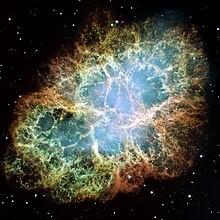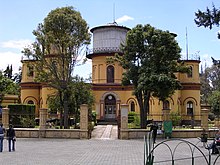EditWatch this pageRead in another language
Astronomy
This article is about the scientific study of celestial objects. For other uses, see Astronomy (disambiguation).
Astar-forming region in theLarge Magellanic Cloud, anirregular galaxy.
A giantHubblemosaic of theCrab Nebula, asupernova remnant
Astronomy, a natural science, is the study ofcelestial objects (such as stars, galaxies,planets, moons, asteroids, comets andnebulae) and processes (such as supernovae explosions, gamma ray bursts, and cosmic microwave background radiation), thephysics, chemistry, and evolution of such objects and processes, and more generally all phenomena that originate outside theatmosphere of Earth. A related but distinct subject, physical cosmology, is concerned with studying the Universe as a whole.[1]
Astronomy is the oldest of the natural sciences. The early civilizations in recorded history, such as the Babylonians, Greeks,Indians, Egyptians, Nubians, Iranians, Chinese, and Maya performed methodical observations of the night sky. Historically, astronomy has included disciplines as diverse as astrometry,celestial navigation, observational astronomyand the making of calendars, but professional astronomy is nowadays often considered to be synonymous with astrophysics.[2]
During the 20th century, the field of professional astronomy split intoobservational and theoretical branches. Observational astronomy is focused on acquiring data from observations of astronomical objects, which is then analyzed using basic principles of physics. Theoretical astronomy is oriented toward the development of computer or analytical models to describe astronomical objects and phenomena. The two fields complement each other, with theoretical astronomy seeking to explain the observational results and observations being used to confirm theoretical results.
Astronomy is one of the few sciences where amateurs can still play an active role, especially in the discovery and observation of transient phenomena. Amateur astronomershave made and contributed to many important astronomical discoveries, such as finding new comets.
EtymologyEdit
19th centurySydney Observatory,Australia(1873)[3]
19th centuryQuito Astronomical Observatoryis located 12 minutes south of theEquatorinQuito,Ecuador.[4]
Astronomy (from the Greek ἀστρονομία fromἄστρον astron, "star" and -νομία -nomia fromνόμος nomos, "law" or "culture") means "law of the stars" (or "culture of the stars" depending on the translation). Astronomy should not be confused with astrology, the belief system which claims that human affairs are correlated with the positions of celestial objects.[5] Although the two fields share a common origin, they are now entirely distinct.[6]
Use of terms "astronomy" and "astrophysics"Edit
Generally, either the term "astronomy" or "astrophysics" may be used to refer to this subject.[7][8][9] Based on strict dictionary definitions, "astronomy" refers to "the study of objects and matter outside the Earth's atmosphere and of their physical and chemical properties"[10] and "astrophysics" refers to the branch of astronomy dealing with "the behavior, physical properties, and dynamic processes of celestial objects and phenomena".[11] In some cases, as in the introduction of the introductory textbook The Physical Universe by Frank Shu, "astronomy" may be used to describe the qualitative study of the subject, whereas "astrophysics" is used to describe the physics-oriented version of the subject.[12] However, since most modern astronomical research deals with subjects related to physics, modern astronomy could actually be called astrophysics.[7] Few fields, such as astrometry, are purely astronomy rather than also astrophysics. Various departments in which scientists carry out research on this subject may use "astronomy" and "astrophysics," partly depending on whether the department is historically affiliated with a physics department,[8] and many professional astronomers have physics rather than astronomy degrees.[9] One of the leading scientific journals in the field is the European journal named Astronomy and Astrophysics. The leading American journals are The Astrophysical Journal and The Astronomical Journal.
HistoryEdit
Main article: History of astronomy
Further information: Archaeoastronomy and List of astronomers
A celestial map from the 17th century, by the Dutch cartographerFrederik de Wit.
In early times, astronomy only comprised the observation and predictions of the motions of objects visible to the naked eye. In some locations, early cultures assembled massive artifacts that possibly had some astronomical purpose. In addition to their ceremonial uses, these observatories could be employed to determine the seasons, an important factor in knowing when to plant crops, as well as in understanding the length of the year.[13]
Before tools such as the telescope were invented, early study of the stars was conducted using the naked eye. As civilizations developed, most notably inMesopotamia, Greece, India, China, Egypt, andCentral America, astronomical observatories were assembled, and ideas on the nature of the Universe began to be explored. Most of early astronomy actually consisted of mapping the positions of the stars and planets, a science now referred to asastrometry. From these observations, early ideas about the motions of the planets were formed, and the nature of the Sun, Moon and the Earth in the Universe were explored philosophically. The Earth was believed to be the center of the Universe with the Sun, the Moon and the stars rotating around it. This is known as the geocentric model of the Universe, or the Ptolemaic system, named after Ptolemy.[14]
A particularly important early development was the beginning of mathematical and scientific astronomy, which began among the Babylonians, who laid the foundations for the later astronomical traditions that developed in many other civilizations.[15] The Babyloniansdiscovered that lunar eclipses recurred in a repeating cycle known as a saros.[16]
Greek equatorialsundial,Alexandria on the Oxus, present-dayAfghanistan3rd–2nd century BCE.
Following the Babylonians, significant advances in astronomy were made in ancient Greece and the Hellenistic world. Greek astronomy is characterized from the start by seeking a rational, physical explanation for celestial phenomena.[17] In the 3rd century BC,Aristarchus of Samos estimated the size and distance of the Moon and Sun, and was the first to propose a heliocentric model of thesolar system.[18] In the 2nd century BC,Hipparchus discovered precession, calculated the size and distance of the Moon and invented the earliest known astronomical devices such as the astrolabe.[19] Hipparchus also created a comprehensive catalog of 1020 stars, and most of the constellations of the northern hemisphere derive from Greek astronomy.[20] The Antikythera mechanism (c. 150–80 BC) was an early analog computerdesigned to calculate the location of the Sun,Moon, and planets for a given date. Technological artifacts of similar complexity did not reappear until the 14th century, when mechanical astronomical clocks appeared inEurope.[21]
During the Middle Ages, astronomy was mostly stagnant in medieval Europe, at least until the 13th century. However, astronomy flourished in the Islamic world and other parts of the world. This led to the emergence of the first astronomical observatories in the Muslim world by the early 9th century.[22][23][24] In 964, the Andromeda Galaxy, the largest galaxy in the Local Group, was discovered by the Persian astronomer Azophi and first described in his Book of Fixed Stars.[25] TheSN 1006 supernova, the brightest apparent magnitude stellar event in recorded history, was observed by the Egyptian Arabic astronomer Ali ibn Ridwan and the Chinese astronomers in 1006. Some of the prominent Islamic (mostly Persian and Arab) astronomers who made significant contributions to the science include Al-Battani, Thebit, Azophi, Albumasar, Biruni,Arzachel, Al-Birjandi, and the astronomers of the Maragheh and Samarkand observatories. Astronomers during that time introduced many Arabic names now used for individual stars.[26][27] It is also believed that the ruins atGreat Zimbabwe and Timbuktu[28] may have housed an astronomical observatory.[29]Europeans had previously believed that there had been no astronomical observation in pre-colonial Middle Ages sub-Saharan Africa but modern discoveries show otherwise.[30][31][32][33]
The Roman Catholic Church gave more financial and social support to the study of astronomy for over six centuries, from the recovery of ancient learning during the late Middle Ages into the Enlightenment, than any other, and, probably, all other, institutions. Among the Church's motives was finding the date for Easter.[34]
Scientific revolutionEdit
Galileo's sketches and observations of theMoonrevealed that the surface was mountainous.
An astronomical chart from an early scientific manuscript. c.1000
During the Renaissance, Nicolaus Copernicusproposed a heliocentric model of the solar system. His work was defended, expanded upon, and corrected by Galileo Galilei andJohannes Kepler. Galileo used telescopes to enhance his observations.[35]
Kepler was the first to devise a system that described correctly the details of the motion of the planets with the Sun at the center. However, Kepler did not succeed in formulating a theory behind the laws he wrote down.[36] It was left to Newton's invention ofcelestial dynamics and his law of gravitationto finally explain the motions of the planets. Newton also developed the reflecting telescope.[35]
The English astronomer John Flamsteedcatalogued over 3000 stars.[37] Further discoveries paralleled the improvements in the size and quality of the telescope. More extensive star catalogues were produced byLacaille. The astronomer William Herschelmade a detailed catalog of nebulosity and clusters, and in 1781 discovered the planetUranus, the first new planet found.[38] The distance to a star was first announced in 1838 when the parallax of 61 Cygni was measured by Friedrich Bessel.[39]
During the 18–19th centuries, attention to thethree body problem by Euler, Clairaut, andD'Alembert led to more accurate predictions about the motions of the Moon and planets. This work was further refined by Lagrangeand Laplace, allowing the masses of the planets and moons to be estimated from their perturbations.[40]
Significant advances in astronomy came about with the introduction of new technology, including the spectroscope andphotography. Fraunhofer discovered about 600 bands in the spectrum of the Sun in 1814–15, which, in 1859, Kirchhoff ascribed to the presence of different elements. Stars were proven to be similar to the Earth's own Sun, but with a wide range of temperatures,masses, and sizes.[26]
The existence of the Earth's galaxy, the Milky Way, as a separate group of stars, was only proved in the 20th century, along with the existence of "external" galaxies, and soon after, the expansion of the Universe, seen in the recession of most galaxies from us.[41]Modern astronomy has also discovered many exotic objects such as quasars, pulsars,blazars, and radio galaxies, and has used these observations to develop physical theories which describe some of these objects in terms of equally exotic objects such as black holes and neutron stars.Physical cosmology made huge advances during the 20th century, with the model of theBig Bang heavily supported by the evidence provided by astronomy and physics, such as the cosmic microwave background radiation,Hubble's law, and cosmological abundances of elements. Space telescopes have enabled measurements in parts of the electromagnetic spectrum normally blocked or blurred by the atmosphere. Recently, in February 2016, it was revealed that the LIGOproject had detected evidence of gravitational waves, in September 2015.
Observational astronomy
Theoretical astronomy
Specific subfields
Interdisciplinary studies
Amateur astronomy
Unsolved problems in astronomy
See also
References
Bibliography
External links
Last edited 12 days ago by Gap9551
 ®
®
Content is available under CC BY-SA 3.0 unless otherwise noted.






Tidak ada komentar:
Posting Komentar